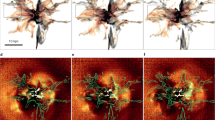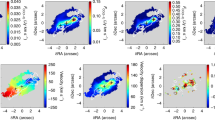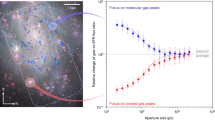Abstract
The Universe’s largest galaxies reside at the centres of galaxy clusters and are embedded in hot gas that, if left undisturbed, would cool quickly and create many more new stars than are actually observed1,2,3,4,5. Cooling can be regulated by feedback from accretion of cooling gas onto the central black hole, but requires an accretion rate finely tuned to the thermodynamic state of the hot gas6,7. Theoretical models in which cold clouds precipitate out of the hot gas via thermal instability and accrete onto the black hole exhibit the necessary tuning8,9,10. Recent observational evidence shows that the abundance of cold gas in the centres of clusters increases rapidly near the predicted threshold for instability11. Here we report observations showing that this precipitation threshold extends over a large range in cluster radius, cluster mass and cosmic time. We incorporate the precipitation threshold into a framework of theoretical models for the thermodynamic state of hot gas in galaxy clusters. According to that framework, precipitation regulates star formation in some giant galaxies, while thermal conduction prevents star formation in others if it can compensate for radiative cooling and shut off precipitation.
This is a preview of subscription content, access via your institution
Access options
Subscribe to this journal
Receive 51 print issues and online access
$199.00 per year
only $3.90 per issue
Buy this article
- Purchase on Springer Link
- Instant access to full article PDF
Prices may be subject to local taxes which are calculated during checkout



Similar content being viewed by others
References
Fabian, A. C. Cooling flows in clusters of galaxies. Annu. Rev. Astron. Astrophys. 32, 277–318 (1994)
Borgani, S. et al. X-ray properties of galaxy clusters and groups from a cosmological hydrodynamics simulation. Mon. Not. R. Astron. Soc. 348, 1078–1096 (2004)
Peterson, J. R. & Fabian, A. C. X-ray spectroscopy of cooling clusters. Phys. Rep. 427, 1–39 (2006)
Nagai, D., Kravtsov, A. V. & Vikhlinin, A. Effects of galaxy formation on the thermodynamics of the intracluster medium. Astrophys. J. 668, 1–14 (2007)
O’Dea, C. P. et al. An infrared survey of brightest cluster galaxies. II. Why are some brightest cluster galaxies forming stars? Astrophys. J. 681, 1035–1045 (2008)
Soker, N., White, R. E., David, L. P. & McNamara, B. R. A moderate cluster cooling flow model. Astrophys. J. 549, 832–839 (2001)
McNamara, B. R. & Nulsen, P. E. J. Mechanical feedback from active galactic nuclei in galaxies, groups, and clusters. New J. Phys. 14, 055023 (2012)
McCourt, M., Sharma, P., Quataert, E. & Parrish, I. Thermal instability in gravitationally-stratified plasma: implications for multiphase structure in clusters and galaxy haloes. Mon. Not. R. Astron. Soc. 419, 3319–3337 (2012)
Sharma, P., McCourt, M., Quataert, E. & Parrish, I. Thermal instability and the feedback regulation of hot halos in clusters and groups of galaxies. Mon. Not. R. Astron. Soc. 420, 3174–3194 (2012)
Gaspari, M., Ruszkowski, M. & Sharma, P. Cause and effect of feedback: multiphase gas in cluster cores heated by AGN jets. Astrophys. J. 746, 94–108 (2012)
Voit, G. M. & Donahue, M. Cooling time, freefall time, and precipitation in the cores of ACCEPT galaxy clusters. Astrophys. J. 799, L1 (2015)
Frenk, C. S. et al. The Santa Barbara Cluster Comparison Project. Astrophys. J. 525, 554–582 (1999)
Voit, G. M., Kay, S. T. & Bryan, G. L. The baseline intracluster entropy profile from gravitational structure formation. Mon. Not. R. Astron. Soc. 364, 909–916 (2005)
Cavagnolo, K. W., Donahue, M., Voit, G. M. & Sun, M. Intracluster medium entropy profiles for a Chandra archival sample of galaxy clusters. Astrophys. J. Suppl. Ser. 182, 12–32 (2009)
Voit, G. M. & Bryan, G. L. Regulation of the X-ray luminosity of clusters of galaxies by cooling and supernova feedback. Nature 414, 425–427 (2001)
Zakamska, N. L. & Narayan, R. Models of galaxy clusters with thermal conduction. Astrophys. J. 582, 162–169 (2003)
Voigt, L. M. & Fabian, A. C. Thermal conduction and reduced cooling flows in galaxy clusters. Mon. Not. R. Astron. Soc. 347, 1130–1149 (2004)
Voit, G. M. Quasi-steady configurations of conductive intracluster media. Astrophys. J. 740, 28–38 (2011)
Bregman, J. N. & David, L. P. Heat conduction in cooling flows. Astrophys. J. 326, 639–644 (1988)
Li, Y. & Bryan, G. L. Modeling active galactic nucleus feedback in cool-core clusters: the balance between heating and cooling. Astrophys. J. 789, 54–67 (2014)
Li, Y. & Bryan, G. L. Modeling active galactic nucleus feedback in cool-core clusters: the formation of cold clumps. Astrophys. J. 789, 153–164 (2014)
Gaspari, M., Ruszkowski, M. & Oh, S. P. Chaotic cold accretion onto black holes. Mon. Not. R. Astron. Soc. 432, 3401–3422 (2013)
Gaspari, M., Ruszkowski, M., Oh, S. P., Brighenti, F. & Temi, P. Chaotic cold accretion onto black holes in rotating atmospheres. Preprint at http://arxiv.org/abs/1407.7531 (2014)
Sharma, P., McCourt, M., Parrish, I. & Quataert, E. On the structure of hot gas in halos: implications for the LX-TX relation and missing baryons. Mon. Not. R. Astron. Soc. 427, 1219–1228 (2012)
Navarro, J. F., Frenk, C. S. & White, S. D. M. A universal density profile from hierarchical clustering. Astrophys. J. 490, 493–508 (1997)
Bernardi, M. et al. The luminosities, sizes, and velocity dispersions of brightest cluster galaxies: implications for formation history. Astron. J. 133, 1741–1755 (2007)
Hoffer, A. S., Donahue, M., Hicks, A. & Barthelemy, R. S. Infrared and ultraviolet star formation in brightest cluster galaxies in the ACCEPT sample. Astrophys. J. Suppl. Ser. 199, 23–38 (2012)
McDonald, M. et al. The growth of cool cores and evolution of cooling properties in a sample of 83 galaxy clusters at 0.3<z<1.2 selected from the SPT-SZ survey. Astrophys. J. 774, 23–45 (2013)
Vikhlinin, A. et al. Chandra Cluster Cosmology Project. II. Samples and X-ray data reduction. Astrophys. J. 692, 1033–1059 (2009)
McDonald, M. et al. A massive, cooling-flow-induced starburst in the core of a luminous cluster of galaxies. Nature 774, 23–45 (2012)
Acknowledgements
G.M.V. and M.D. acknowledge NSF support through grant AST-0908819. G.L.B. acknowledges NSF AST-1008134, AST-1210890, NASA grant NNX12AH41G, and XSEDE Computational resources. M.McD. acknowledges support by NASA through a Hubble Fellowship grant HST-HF51308.01-A awarded by the Space Telescope Science Institute, which is operated by the Association of Universities for Research in Astronomy, Inc., for NASA, under contract NAS 5-26555.
Author information
Authors and Affiliations
Contributions
G.M.V.: theoretical models, data interpretation, manuscript preparation; M.D.: data analysis, data interpretation, discussions, manuscript review; G.L.B.: theoretical models, discussions, manuscript review; M.McD.: data analysis, discussions, manuscript preparation, manuscript review.
Corresponding author
Ethics declarations
Competing interests
The authors declare no competing financial interests.
Rights and permissions
About this article
Cite this article
Voit, G., Donahue, M., Bryan, G. et al. Regulation of star formation in giant galaxies by precipitation, feedback and conduction. Nature 519, 203–206 (2015). https://doi.org/10.1038/nature14167
Received:
Accepted:
Published:
Issue Date:
DOI: https://doi.org/10.1038/nature14167
This article is cited by
-
The formation of dusty cold gas filaments from galaxy cluster simulations
Nature Astronomy (2020)
-
Observational constraints on the feeding of supermassive black holes
Nature Astronomy (2019)
-
Hot Atmospheres, Cold Gas, AGN Feedback and the Evolution of Early Type Galaxies: A Topical Perspective
Space Science Reviews (2019)
-
Constraining Gas Motions in the Intra-Cluster Medium
Space Science Reviews (2019)
-
Active Galactic Nucleus Feedback with the Square Kilometre Array and Implications for Cluster Physics and Cosmology
Journal of Astrophysics and Astronomy (2017)
Comments
By submitting a comment you agree to abide by our Terms and Community Guidelines. If you find something abusive or that does not comply with our terms or guidelines please flag it as inappropriate.



